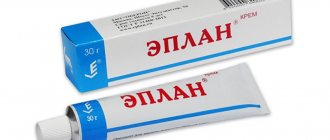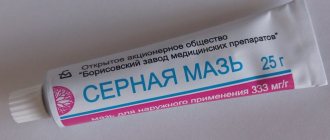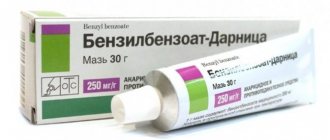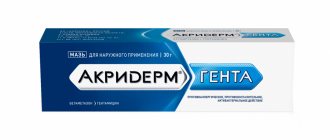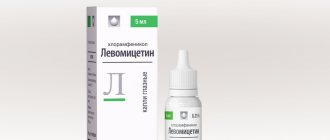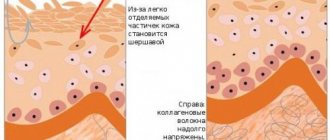Pharmacodynamics and pharmacokinetics
Pharmacodynamics
Ofloxacin is a fluoroquinolone ( quinolonic acid ), an antibacterial drug that has a bactericidal effect.
The spectrum of antibacterial action of ofloxacin : facultative anaerobes, obligate anaerobes, aerobes and some other bacteria, such as Chlamydia.
The incidence of acquired resistance of individual types of microorganisms varies depending on the region and changes over time. Therefore, the key to prescribing the correct treatment for infections is to have information about local resistance. Cross-resistance between ofloxacin and other fluoroquinolones .
The most sensitive species:
- gram-positive aerobic bacteria Staphylococcus aureus, Bacillus spp.;
- gram-negative aerobic bacteria Acinetobacter lwoffi, Acinetobacter baumannii, Escherichia coli, Haemophilus influenzae, Klebsiella oxytoca, Enterobacter cloacae, Proteus mirabilis, Haemophilus parainfluenzae, Moraxella catarrhalis, Klebsiella pneumoniae, Serratia marcescens.
Species in which acquired resistance may be present:
- gram-positive aerobic bacteria Enterococcus faecalis, Corynebacterium spp., mecytilene-resistant strains of Streptococcus pneumoniae, Staphylococcus aureus, Staphylococcus epidermidis;
- gram-negative aerobic bacteria Stenotrophomonas maltophilia, Pseudomonas aeruginosa.
Species with innate resistance:
- gram-positive aerobic bacteria Enterococcus spp.
Pharmacokinetics
The effectiveness of the drug depends on the ratio of its highest concentration in the tissue and the minimum inhibitory concentration of the pathogen.
With repeated use, the drug accumulates in the vitreous body in therapeutic concentrations. After administering the drug 5 times a day with an exposure of 5 minutes, after 1-2 hours the concentration in the intraocular fluid becomes maximum, and after another 5-6 hours it decreases to zero.
The half-life of Floxal from the blood when used regularly is from 3 to 7 hours.
Pharmacological properties of the drug Floxal
Pharmacodynamics . Ofloxacin is an antimicrobial agent of the fluoroquinolone group, a derivative of quinolonic acid (DNA gyrase inhibitor). Acts bactericidal. Bactericidal spectrum The spectrum of action includes obligate anaerobes, facultative anaerobes, aerobes and other infectious agents such as chlamydia. Below is information about the sensitivity to ofloxacin of microorganisms that are most often the causative agents of eye infections. When applied topically, significantly higher concentrations of the antibiotic were achieved, so clinical effectiveness is observed even with pathogens that have been determined to be resistant in the laboratory. Microorganisms sensitive to ofloxacin (resistance ≤10%) Gram-positive aerobes: Staphylococcus aureus (sensitive to methicillin), Streptococcus pneumoniae and other streptococci, corynebacteria, Bacillus . Gram-negative aerobes: Haemophilus influenzae, Haemophilus parainfluenzae, Enterobacteriaceae (Escherichia coli, Proteus mirabilis, Klebsiella oxytoca, Serratia marcescens, Enterobacter cloacae, Klebsiella pneumoniae), Pseudomonas aeruginosa (pathogens of community-acquired infections), Acinetobacter baumannii, Acinetobacter lwoffii, Moraxella catarrhalis . Microorganisms less sensitive to ofloxacin (resistance 10%) Gram-positive aerobes: Staphylococcus aureus (resistant to methicillin), coagulase-negative staphylococci, enterococci. Gram-negative aerobes: Pseudomonas aeruginosa (pathogens of nosocomial infections), Stenotrophomonas maltophilia. Pharmacokinetics . In experimental studies on animals, it was found that after topical application, ofloxacin is detected in the cornea, conjunctiva, eye muscles, sclera, iris, ciliary body and in the anterior chamber of the eye. Repeated use also leads to the achievement of therapeutic concentrations of ofloxacin in the vitreous body. Drops . When 0.3% ofloxacin eye drops are instilled 5 times with an interval of 5 minutes, the concentration in the aqueous humor of the eye after 60–120 minutes is 1.2–1.7 μg/ml. After 3 hours, the concentration decreases to 0.8 μg/ml. Depending on the frequency of instillation, after 5–6 hours the concentration of ofloxacin in the aqueous humor of the eye decreases to zero. Because ofloxacin can bind to tissues containing melanin, delayed clearance of the drug from these tissues may occur. It can be assumed that a higher concentration of the drug is created in the tissues of the eye than in the aqueous humor of the eye. Ointment . After a single application of an approximately 1 cm strip of ointment (equivalent to 0.12 mg ofloxacin), maximum concentrations of ofloxacin in the conjunctiva (9.72 µg/g) and sclera (1.61 µg/g) are reached after 5 minutes, after which ofloxacin concentrations slowly decreases. The concentration of ofloxacin in the aqueous humor of the eye and cornea reaches maximum values after 1 hour (0.69 and 4.87 μg/g, respectively).
Indications for use
Infectious diseases of the anterior organ of vision caused by microorganisms sensitive to the drug:
- corneal ulcer;
- barley;
- blepharitis;
- conjunctivitis;
- keratitis;
- dacryocystitis;
- chlamydial eye infection.
As well as the prevention and treatment of infectious complications after surgical interventions and eye injuries.
Side effects
Severe reactions after regular use of ofloxacin rarely develop, most of them are reversible.
Immediately after using the drug, blurred vision may appear, which disappears after a few minutes.
- From the immune system: conjunctival hyperemia , Quincke's edema , burning sensation in the eye, anaphylactic reactions, oropharyngeal edema .
- From the nervous system: dizziness .
- From the eye: discomfort in the eyes, irritation, keratitis , blurred vision, conjunctivitis , photophobia, dry eyes, lacrimation.
- From the digestive system: nausea.
- Skin: swelling of the face and periorbital area.
There is evidence that when used locally, Stevens-Johnson syndrome and toxic epidermal necrosis . The cause-and-effect relationship of such manifestations with ofloxocin has not been established.
Instructions for use of Floxal
Floxal eye drops instructions for use require 1 drop to be instilled into the eyelid of the affected eye 3-4 times a day.
The instructions for Floxal eye ointment also recommend using the drug conjunctivally. A strip of ointment up to 1.5 cm is placed in the conjunctival sac 2-3 times a day, for chlamydial lesions - 5 times a day. Ointment and eye drops are not recommended for use for more than 2 weeks.
You can combine eye ointment and Floxal drops. When taking more than one topical medication together, the ointment should be used last.
Use of the drug Floxal
Drops Adults and children usually instill 1 drop of 0.3% solution into the conjunctival sac of the affected eye 4 times a day. The duration of use of eye drops should not exceed 2 weeks. Ointment For adults and children, a 1 cm long strip of ointment (equivalent to 0.12 mg ofloxacin) is usually injected into the conjunctival sac of the affected eye 3 times a day (for chlamydial infections - 5 times a day). The duration of treatment with 0.3% Floxal eye ointment should not exceed 2 weeks. To administer the ointment/drops, carefully pull the lower eyelid down and, lightly pressing the tube/bottle with a dropper, insert a strip of ointment 1 cm long/1 drop of solution into the conjunctival sac. Then close the eyelid and move the eyeball to distribute the ointment evenly.
special instructions
If an allergic reaction to Floxal occurs, use should be discontinued.
Before the first administration of the drug, it is recommended to conduct a microbiological culture of material taken from the conjunctival sac to determine the sensitivity of bacteria to ofloxacin .
With long-term use, the development of bacterial resistance and the appearance of microorganisms insensitive to the drug are possible. If symptoms intensify or there is no clinical improvement, discontinue treatment with Floxal and begin alternative therapy.
During the treatment period, it is prohibited to use hard contact lenses. Therefore, you need to remove such lenses before using the drug and put them on 20 minutes after instillation.
Special instructions for the use of the drug Floxal
During treatment with Floxal, you should not use soft contact lenses. During pregnancy and breastfeeding . Despite the absence of any data on the presence of embryotoxic effects in the drug, Floxal should, if possible, not be used during pregnancy and lactation. Children . Floxal eye drops and eye ointment 0.3% can be used in children, including newborns. The ability to influence reaction speed when driving vehicles and working with machinery . The use of Floxal does not affect the patient's reaction rate. But even when the drug is used in accordance with the recommendations, it can affect visual perception for several minutes, so the patient should refrain from driving vehicles or working with potentially dangerous mechanisms until vision is restored.
Floxal price
The price of Floxal eye drops in Russia is 177-222 rubles, and eye ointment will cost 225-297 rubles.
In Ukraine, the average price of drops is 68 hryvnia, and the price of Floxal ointment fluctuates around 69-73 hryvnia.
- Online pharmacies in RussiaRussia
- Online pharmacies in UkraineUkraine
- Online pharmacies in KazakhstanKazakhstan
ZdravCity
- Floxal eye ointment
0.3% 3gDr.Gerhard Mann, Chem.-Pharm.Fabrik GmbH RUR 157 order - Floxal eye drops 0.3% 5mlDr.Gerhard Mann, Chem.-Pharm.Fabrik GmbH
RUB 169 order
Pharmacy Dialogue
- Floxal ointment (tube 0.3% 3g)Dr. Gerhard Mann
167 RUR order
- Floxal (eye drops 0.3% 5ml)Dr. Gerhard Mann
RUB 202 order
show more
Pharmacy24
- Floxal 0.3% 5 ml drops Dr. Gerhard Mann Chem.-Pharm.
Fabrik GmbH, Nimechchyna 133 UAH.order - Floxal 0.3% 3 g ointment Dr. Gerhard Mann Chem.-Pharm. Fabrik GmbH, Nimecchina
136 UAH order
PaniPharmacy
- Floxal liquid Floxal h/c 0.3% 5ml Germany, Dr. Mann
148 UAH order
- Floxal ointment Floxal eye ointment 0.3% 3g Germany, Dr. Mann
155 UAH order
show more


